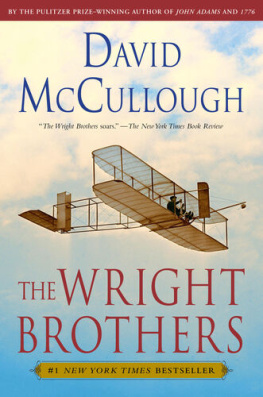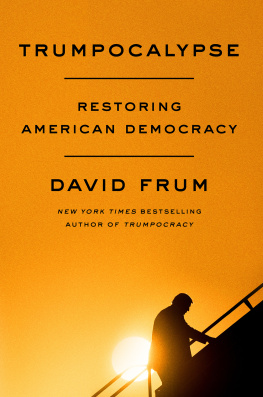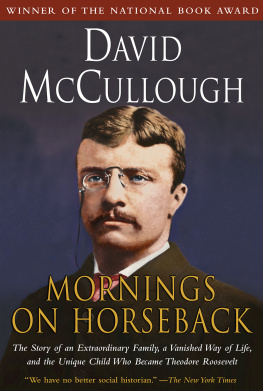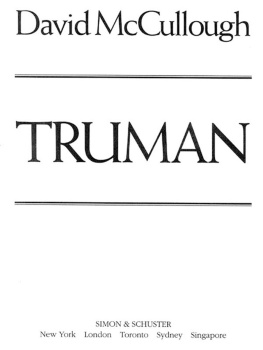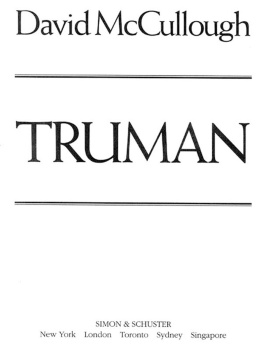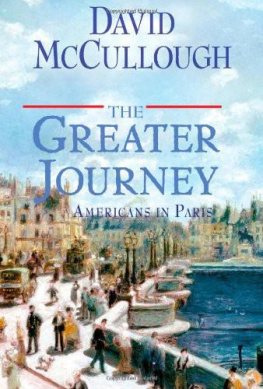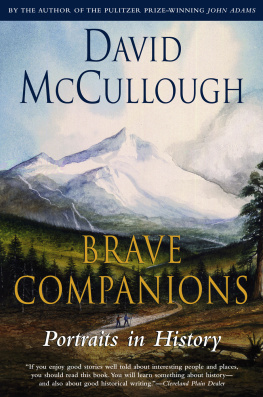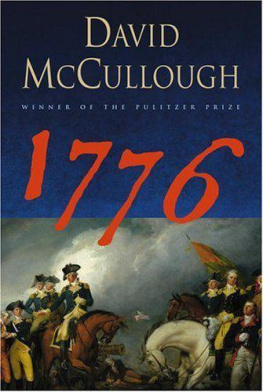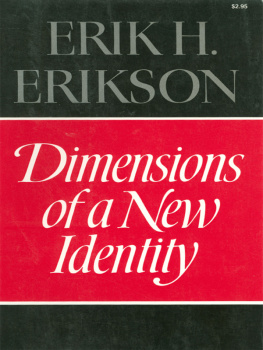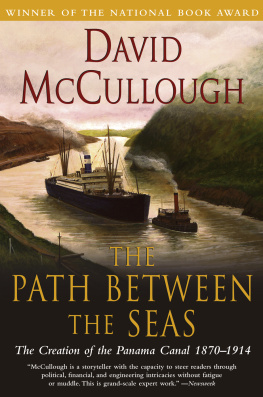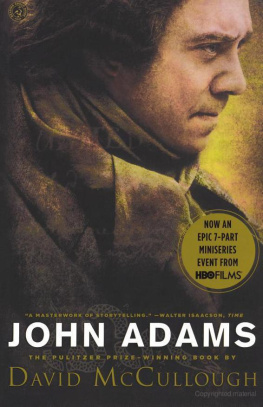By David McCullough
JOHN ADAMS
TRUMAN
BRAVE COMPANIONS
MORNINGS ON HORSEBACK
THE PATH BETWEEN THE SEAS
THE GREAT BRIDGE
THE JOHNSTOWN FLOOD
Contents
WASHINGTON, D.C.
MAY 15, 2003

D r. Cole, ladies and gentlemen, to be honored as I am tonight in the capital of our country, in the presence of my family and many old friends, is for me almost an out-of-body experience. Had someone told me forty years ago, as I began work on my first book, trying to figure out how to go about it, that I would one day be standing here, the recipient of such recognition, I would, I think, have been stopped dead in my tracks.
Ive loved the work, all the way alongthe research, the writing, the rewriting, so much that Ive learned about the history of the nation and about human nature. I love the great libraries and archives where Ive been privileged to work, and I treasure the friendships Ive made with the librarians and archivists who have been so immensely helpful. Ive been extremely fortunate in my subjects, I feel. The reward of the work has always been the work itself, and more so the longer Ive been at it. And Ive kept the most interesting company imaginable with people long gone. Some Ive come to know better than many I know in real life, since in real life we dont get to read other peoples mail.
I have also been extremely fortunate in the tributes that have come my way. But this singular honor, the Jefferson Lecture, is for me a high point, and my gratitude could not be greater.

A MONG THE DARKEST TIMES in living memory was the early part of 1942when Hitlers armies were nearly to Moscow; when German submarines were sinking our oil tankers off the coasts of Florida and New Jersey, within sight of the beaches, and there was not a thing we could do about it; when half our navy had been destroyed at Pearl Harbor. We had scarcely any air force. Army recruits were drilling with wooden rifles. And there was no guarantee that the Nazi war machine could be stopped.
It was then, in 1942, that the classical scholar Edith Hamilton issued an expanded edition of her book, The Greek Way, in which, in the preface, she wrote the following:
I have felt while writing these new chapters a fresh realization of the refuge and strength the past can be to us in the troubled present.... Religion is the great stronghold for the untroubled vision of the eternal, but there are others too. We have many silent sanctuaries in which we can find breathing space to free ourselves from the personal, to rise above our harassed and perplexed minds and catch sight of values that are stable, which no selfish and timorous preoccupations can make waver, because they are the hard-won permanent possessions of humanity....
When the world is storm-driven and the bad that happens and the worse that threatens are so urgent as to shut out everything else from view, then we need to know all the strong fortresses of the spirit which men have built through the ages.
In the Rotunda of the Capitol hangs a large painting of forty-seven men in a room. The scene is as familiar, as hallowed a moment in our history as any we have.
John Trumbulls Declaration of Independence [shown on the cover of this book] has been a main attraction on Capitol tours for a very long time, since 1826. It draws crowds continuously, as it should, every dayfrom three to five million people a year. Its probably been seen by more Americans than any painting everand the scene as portrayed never took place.
Trumbull said it was meant to represent July 4, 1776, and thats the popular understanding. But the Declaration of Independence was not signed on July 4. The signing began on August 2, and continued through the year as absent delegates returned to Philadelphia. No formal signing ceremony ever took place.
The scene comes closer to portraying June 28, when Thomas Jefferson submitted his first draft of the Declaration. But then, too, there was no such dramatic gathering.
The room is wrong, the doors are in the wrong place. The chairs are wrong. (They were Windsor chairs of the plainest kind.) There were no heavy draperies at the windows. The decorative display of military trophies and banners on the back wall is purely Trumbulls way of dressing the set.
Yet none of this really matters. What does matter greatlyparticularly in our own dangerous, uncertain timeis the symbolic power of the painting, and where Trumbull put the emphasis.
The scene proclaims that in Philadelphia in the year 1776 a momentous, high-minded statement of far-reaching consequence was committed to paper. It was not the decree of a king or a sultan or emperor or czar, or something enacted by a far-distant parliament. It was a declaration of political faith and brave intent freely arrived at by an American congress. And that was something entirely new under the sun.
And there Trumbull has assembled them, men like other men, each, importantly, a specific, identifiable individual.
The accuracy is in the faces. John Adams, Thomas Jefferson, and Benjamin Franklin were painted from life. Before he was finished, Trumbull painted or sketched thirty-six of the faces from life. It took him years, and he spared no expense, because he wanted it right. He wanted us to know who they were.
Adams, Jefferson, and Franklin stand front and center exactly as they did in the real drama of the Revolution.
A number who signed the Declaration are not shown. Several who did not sign are present.
Most conspicuous by his absence is George Washington, who had departed Congress the year before to take command of the army.

L ORD B OLINGBROKE , the eighteenth-century political philosopher, said that history is philosophy teaching by examples. Thucydides is reported to have said much the same thing two thousand years earlier.
Jefferson saw history as largely a chronicle of mistakes to be avoided.
Daniel Boorstin, the former Librarian of Congress, has wisely said that trying to plan for the future without a sense of the past is like trying to plant cut flowers.
One might also say that history is not about the past. If you think about it, no one ever lived in the past. Washington, Jefferson, John Adams, and their contemporaries didnt walk about saying, Isnt this fascinating living in the past! Arent we picturesque in our funny clothes! They lived in the present. The difference is it was their present, not ours. They were caught up in the living moment exactly as we are, and with no more certainty of how things would turn out than we have.
Nor were they gods. Indeed, to see them as gods or godlike is to do disservice to their memories. Gods, after all, dont deserve a lot of credit because they can do whatever they wish.
Those we call the Founders were living men. None was perfect. Each had his human flaws and failings, his weaknesses. They made mistakes, let others down, let themselves down.
Washington could be foolhardy and ill-tempered. Adams could be vain, irritable; Jefferson evasive, at times duplicitous. And even in their day, many saw stunning hypocrisy in the cause of liberty being championed by slave masters.
They were imperfect mortals, human beings. Jefferson made the point in the very first line of the Declaration of Independence. When in the course of human events... The accent should be on the word human.
And of course their humanity is not evident only in their failings. Its there in Adamss heart-felt correspondence with his wife and children, in Jeffersons love of gardening, his fascination, as he said, in every blade of grass that grows.
Next page
